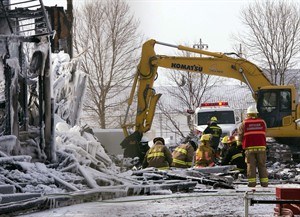
Emergency workers search through the frozen rubble of a seniors residence Friday, January 24, 2014 in L'Isle-Verte, Que., following a fatal fire.THE CANADIAN PRESS/Ryan Remiorz
January 25, 2014 - 4:00 AM
Firefighters searching for possible victims encased in thick ice face a "daunting" task that requires as much skill and finesse as an archeological dig, one expert said as crews continue to comb through the frozen site of a deadly fire in Quebec.
Emergency crews in L'Isle-Verte are using steam to melt the ice while still preserving the bodies they are looking for in the rubble of the Residence du Havre seniors home. Eight people died in Thursday's fire and another 30 are missing.
Fire-ravaged buildings become even more treacherous when coated with heavy ice, said Saskatoon Fire Chief Dan Paulsen, who is not involved with the Quebec operation but has dealt with similar situations on his turf.
"You've got massive instability in the structure simply because of the amount of weight that is there, and if anything is still standing, that's in a collapsible position," he said.
In some cases, Paulsen said, the safety risks are so high that the investigation is called off altogether and what caused the blaze is left unknown.
That isn't an option when there are victims inside, he said.
"It is a daunting task that they're facing because people want to lay their loved ones to rest and I fully understand that," he said.
"I obviously want to extend my deepest sympathies for (the families') loss."
At the same time, the recovery effort must be carried out without compromising firefighters' safety, he said.
Safeguarding the remains must also be a priority, the fire chief said, describing it as painstaking work that calls for a delicate hand as well as an arsenal of equipment.
"I would probably akin that to archeology," he said.
The only way to collect the bodies and potential evidence is to thaw the wreckage, he said.
One possible method involves building a new structure out of scaffolding and insulated sheathing around the rubble and pumping heat inside, he said.
Steam — the approach chosen by the Quebec crews — is another option, Paulsen said.
A device "like a big pressure washer" is used to blast the ice, while another machine sucks up the runoff before it can freeze again, he said.
Back hoes and other excavators can also be employed, along with breaking hammers.
When the structure is too unstable, however, the solution may be to rely on Mother Nature, he said.
"It is not the most desirable option but when you start looking though at putting life risk..." he said.
"Those are difficult decisions that have to be made by those involved."
News from © The Canadian Press, 2014